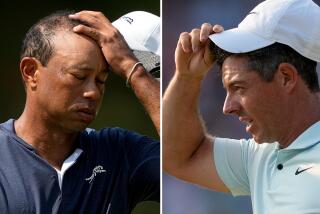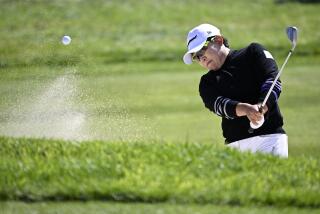Major’s a major, even the PGA
- Share via
Ever since scrapping match play as its format 50 years ago, the PGA Championship has suffered an identity crisis.
The Masters is the youngest of the four majors, yet perhaps the most familiar because it’s always at Augusta National. The U.S. Open bills itself as the toughest test in golf. The British Open is the only major played on a links course.
And what does that make the PGA Championship?
“The other one,” Geoff Ogilvy said with a grin, giving up on a quick search for the proper description. “It’s hard to stand out against those. That’s some pretty good competition. But it doesn’t make it any less.”
It will be no less valuable to win, especially for the long list of players without a major this year (Phil Mickelson) or ever (Sergio Garcia). The PGA Championship starts Thursday at Oakland Hills with so much on the line for so many players.
“It’s a major, and it’s one I’d love to win,” said Steve Stricker, the runner-up 10 years ago at Sahalee. “It’s always gotten a bad rap, but I still perceive it as one that’s very important. Being the fourth one, maybe guys build up a tolerance of the pressure and everything. But again, it’s a major. A lot of guys get their first major win there. So it provides a lot of hope for a lot of players.”
Maybe that’s what the PGA of America had in mind when it came up with the motto, “Glory’s Last Shot.”
It certainly rings true for Mickelson, has gone 10 majors without winning, and Ernie Els, who has gone six years without winning a major, the longest drought of his career. Garcia is now 0-for-37 in the majors as a pro, and so much more was expected out of him when he won The Players Championship.
Mickelson might be the most intriguing at Oakland Hills.
Despite winning at Riviera and Colonial, his season has been quiet in the majors. It is similar to how he was in 2005 when he finished a combined 36 shots out of the lead at the first three majors, then made it a great year by winning the PGA Championship at Baltusrol.
“I’ve got a newfound energy for the end of the season,” Mickelson said. “I’ve been practicing hard, and I’m excited.”
And for the second time in a major, no one has to worry about two-time defending champion Tiger Woods.
The world’s No. 1 player collected his 14th major at the U.S. Open, outlasting Rocco Mediate in a playoff. Woods had reconstructive surgery on his left knee two weeks later and is done for the year, making him the first defending PGA champion not to play since Ben Hogan was recovering from near-fatal injuries he suffered in a car accident in 1949.
It was Hogan who made Oakland Hills famous by referring to it as a “monster” after he won the 1951 U.S. Open. That monster has even more muscle now, stretched to 7,395 yards as a par 70 with some of the most frightening greens in golf.
At least the course has an identity.
The PGA Championship is still working on one, although chief executive Joe Steranka said it has made significant progress the last few decades. It traditionally has the strongest field in golf, with 97 of the top 100 in the world ranking expected to play. No other major in the last 10 years has such a strong cast of winners -- Woods four times, Vijay Singh twice and Mickelson.
And instead of defending its spot in the lineup, the PGA of America embraced it.
“We were looking for something that said, ‘This is the season’s final major and your last shot at glory,’” Steranka said. “When you win a tournament on the tour, you go into the record books. When you win a major, you go into the history books.”
Dow Finsterwald went into the history books for a couple of reasons in 1958. Not only was it his first major, he became the first player to win the Wanamaker Trophy by playing only 72 holes.
That was the year the PGA Championship switched to stroke play.
Finsterwald was the runner-up a year earlier in the final edition of match play and he endured 175 holes -- four rounds of 18-hole matches, with 36-hole matches from the quarterfinals on. He lost to Lionel Hebert, 2 and 1, in the championship match.
“One was a little more fun than the other,” Finsterwald said from his home in Colorado.
Finsterwald found little difference in the pressure he faced late Sunday afternoon. In 1957, he was 1 down to Hebert when his approach found a creek on the 16th hole, effectively ending the tournament. A year later, he was tied with Sam Snead when he saved par on the 12th while Snead four-putted for double bogey.
But he clearly remembers the mixed feelings about leaving match play.
“There were people who thought the association was wrong for giving up on match play,” Finsterwald said. “But if you look back, television was coming on. And match play didn’t lend itself to TV. The other thing about match play is that golf was becoming more popular, and with the gallery being so large, you got to the semifinals and had 25,000 people trying to watch two matches.”
He also pointed out one other problem that is true even today.
“You run the risk of not having Tiger in the final,” he said.
Snead played that starring role in 1957, and it was Finsterwald who eliminated him in the fourth round in 1957.
“I wasn’t a household name,” he said. “And I’m not sure they got the attendance they hoped for.”
Match play made a brief return to golf in the 1980s, an experiment that lasted only two years. It was resurrected in 1999 as part of the World Golf Championships, and there is a place for it one time on the PGA Tour schedule.
But for a major?
“If it turned out like this year, everybody would love match play,” Ogilvy said, referring to Woods winning for the third time, and reaching the finals for the fourth time in nine years. “But if Tiger and Phil go out in the first two rounds, everybody goes home. Imagine planning your whole year around watching Tiger or Phil play in the PGA, you get a Saturday ticket and they’re already gone.”
In its place is a major that looks like the others, minus an identity that has been easy to market. Even so, the PGA Championship has delivered some great moments over the last 20 years, from the arrival of John Daly to the rainbow for Davis Love III, from Woods’ playoff win over unheralded Bob May to David Toms laying on the final hole and beating Mickelson with a par putt.
“If you had to rank it, the PGA is probably fourth on everyone’s list,” Tim Clark said. “But ask a player if he wants to win it, and I’ll guarantee he’ll tell you ‘Yes.’ When it comes to winning a major, it really doesn’t matter which one.”
More to Read
Go beyond the scoreboard
Get the latest on L.A.'s teams in the daily Sports Report newsletter.
You may occasionally receive promotional content from the Los Angeles Times.










